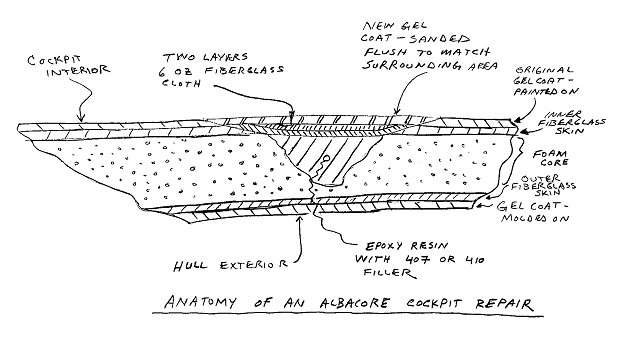By Barney Harris 6701 & 8011
Cored hull Albacores are somewhat susceptible to damage to the floor of their cockpits. This damage can take the form of an indentation from a concentrated point load from stepping on a small hard object such as a pebble or tool. This will poke through the inner fibreglass skin and into the foam core. Another common form of damage occurs when the hull has a point load applied outside the hull – as from improperly positioned trailer bunks or setting the hull on the ground with an uneven surface.. This will create a crack or series of cracks on the hull’s interior, usually aligned fore n aft. Fortunately repairing this sort of damage is straightforward. I have done these repairs to several boats including my own, and have developed the following process.
First, none of the materials work if the surface is wet, so I will dry the boat thoroughly by storing it uncovered in a waterless area for at least a week. Gentle heating from a small lamp will assist this.
There is probably more than one area which needs repair, so mark off all the damaged areas. I use a pencil or magic marker to identify each area on the inner hull to be repaired. Next, use an electric grinder to remove the gel coat for about one inch surrounding each damaged area. Be careful, the fibreglass skin is pretty delicate and its very easy to remove more than necessary.
Next, inspect the underlying core material. It should be completely dry. If it is not, heat the area and allow time to elapse until it has fully dried. Sometimes the object which created the dent – like a pebble – will be lodged in the hole. Pry it out.
Next, fill the dent with epoxy filler such as west 105 resin and 205 or 206 hardener with a lightweight filler such as the West 407 or 410. Apply a thin coat of pure resin to the area being filled to ensure a good bond. Then mix the filler into the remaining resin until you reach a mayonnaise or peanut butter consistency. Apply the filler with a putty knife and fair it into the surrounding area as well as you can. Allow this to cure overnight.

Now, prepare for a fibreglass patch by sanding the cured filler area flush with the surrounding area and wiping it down with acetone and a clean paper towel. Carefully mask off the area to be coated so that inadvertent spills do not mess up the boat interior. Cut two pieces of 6 ounce fibreglass cloth to the exact shape of the area being repaired.
Now, mix a small batch of West epoxy resin and paint the damage area with a thin coat. Apply one piece of fibreglass cloth and wet out with resin completely by dabbing with a small brush. Try to use a little resin as possible. Apply the second piece of fibreglass cloth and wet it out with resin. The cure can be sped by gentle heating with a 75 watt light bulb if desired. Watch for drips – clean them up before they harden
Bare epoxy will not last long in the sun, which is why fibreglass Albacores have the “gel coat” opaque surface finish. This protective barrier must be restored in the area of the repair. I have found the white gel coat sold in West Marine serves well and is nearly a perfect match for the white gel coat used in the Ontario Yachts Albacores. One can match the colour of a non white surface by tinting the gel coat with a colouring additive. Best to attempt a test batch first to ensure the cured colour matches.
Prepare the area for gel coating by sanding with 100 grit paper and wiping it down with acetone and a clean paper towel. This is very important since the epoxy exudes a waxy substance, referred to as an “amine blush” in their literature, when it cures which will prevent succeeding coatings from adhering.
Mix the gel coat in accordance with the directions on the can. Gel coat can be applied like paint. If a thicker mixture is desired to say fill a deeper depression, mix in a little colloidal silica. The cure can be hastened by gentle heating with a 75 watt lamp.
Gel coat will not cure fully when in contact with air, so it is necessary to isolate it while it cures. After the gel coat has become somewhat solidified, usually after 30 or 45 minutes, apply a light coat of PVA to isolate it from air. The PVA dries to form a thin wax barrier over the gel coat, and ensures a full cure.
Finish the repair by removing the masking and washing off the PVA with soap and water. Sand the gel coat to match the surrounding area. If in the cockpit, sanding with 220 wet will suffice. If on the deck or other smooth, shiny area, sand with 220 through 1000 grit. For a final finish, buff with a rubbing compound. It is possible for an amateur to match gel coat reasonably well, but it takes a little time and effort. A repair made using the procedures and materials outlined above should last the life of the boat.
